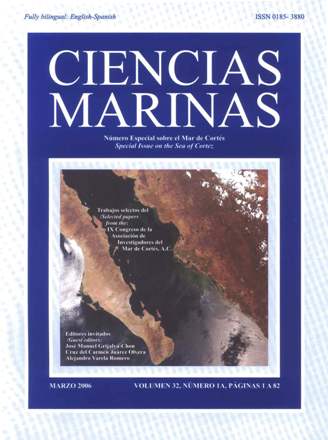Spatiotemporal variability of some shallow-bottom macroinvertebrates (Gastropoda, Bivalvia and Echinodermata) from Espritu Santo Archipelago, Baja California Sur, Mexico.
Main Article Content
Abstract
Four surveys (October 2001, and January, April and June 2002) were conducted at nine sites around the Espíritu Santo Archipelago, Baja California Sur, Mexico, to identify spatiotemporal variation patterns in the structure of the rocky, shallowbottom macroinvertebrate community. The abundance of the conspicuous macrobenthos (gastropods, bivalves and echinoderms) was estimated visually by free diving at 4–6 m depth along two band-transects parallel to the coastline. Each transect was 5 m wide and 50 m long, covering an area of 500 m2 per site. Sea surface temperature, wave exposure, type of substrate and slope were also recorded. Thirty-two species were identified. The echinoderms were the best represented group, with 18 species from 13 families, followed by the molluscs, with 14 species from 13 families. The highest mean abundance and density values were recorded for Tripneustes depressus (140.25 ± 64.21 ind and 0.28 ind m–2, respectively). There were no significant differences indiversity, equitability and species richness among sampling months, though differences were found among sites (P < 0.05). A spatial diversity pattern was identified, with low values (0.4 bits ind–1) for exposed shores and high values (2.0 bits ind–1) for semi-protected areas.
Downloads
Article Details
This is an open access article distributed under a Creative Commons Attribution 4.0 License, which allows you to share and adapt the work, as long as you give appropriate credit to the original author(s) and the source, provide a link to the Creative Commons license, and indicate if changes were made. Figures, tables and other elements in the article are included in the article’s CC BY 4.0 license, unless otherwise indicated. The journal title is protected by copyrights and not subject to this license. Full license deed can be viewed here.

